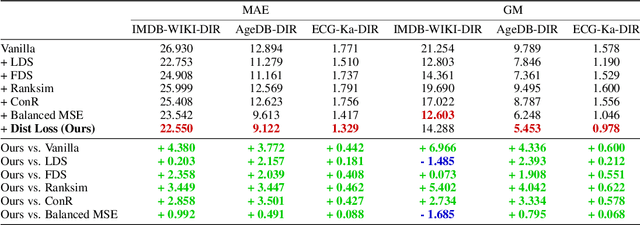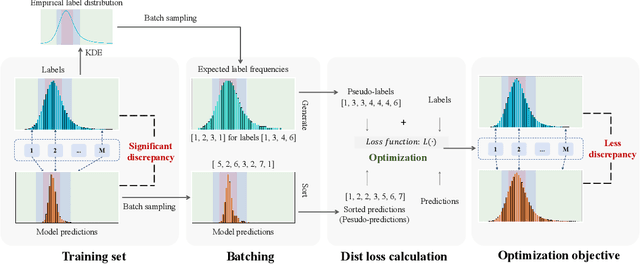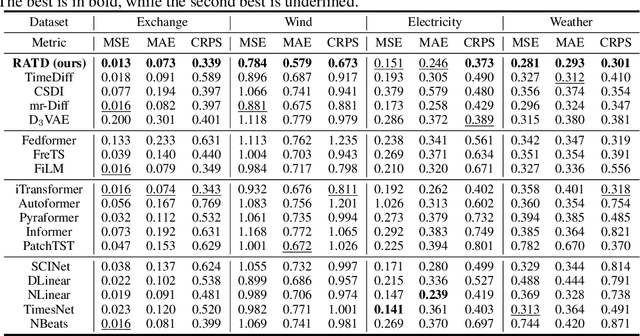Shenda Hong
National Institute of Health Data Science, Peking University, Beijing, China, Department of Emergency Medicine, Peking University First Hospital, Beijing, China
Copy-Paste to Mitigate Large Language Model Hallucinations
Oct 01, 2025Abstract:While Retrieval-Augmented Generation (RAG) enables large language models (LLMs) to generate contextually grounded responses, contextual faithfulness remains challenging as LLMs may not consistently trust provided context, leading to hallucinations that undermine reliability. We observe an inverse correlation between response copying degree and context-unfaithful hallucinations on RAGTruth, suggesting that higher copying degrees reduce hallucinations by fostering genuine contextual belief. We propose CopyPasteLLM, obtained through two-stage high-copying response preference training. We design three prompting methods to enhance copying degree, demonstrating that high-copying responses achieve superior contextual faithfulness and hallucination control. These approaches enable a fully automated pipeline that transforms generated responses into high-copying preference data for training CopyPasteLLM. On FaithEval, ConFiQA and PubMedQA, CopyPasteLLM achieves best performance in both counterfactual and original contexts, remarkably with 12.2% to 24.5% accuracy improvements on FaithEval over the best baseline, while requiring only 365 training samples -- 1/50th of baseline data. To elucidate CopyPasteLLM's effectiveness, we propose the Context-Parameter Copying Capturing algorithm. Interestingly, this reveals that CopyPasteLLM recalibrates reliance on internal parametric knowledge rather than external knowledge during generation. All codes are available at https://github.com/longyongchao/CopyPasteLLM
Simultaneous Polysomnography and Cardiotocography Reveal Temporal Correlation Between Maternal Obstructive Sleep Apnea and Fetal Hypoxia
Apr 17, 2025Abstract:Background: Obstructive sleep apnea syndrome (OSAS) during pregnancy is common and can negatively affect fetal outcomes. However, studies on the immediate effects of maternal hypoxia on fetal heart rate (FHR) changes are lacking. Methods: We used time-synchronized polysomnography (PSG) and cardiotocography (CTG) data from two cohorts to analyze the correlation between maternal hypoxia and FHR changes (accelerations or decelerations). Maternal hypoxic event characteristics were analyzed using generalized linear modeling (GLM) to assess their associations with different FHR changes. Results: A total of 118 pregnant women participated. FHR changes were significantly associated with maternal hypoxia, primarily characterized by accelerations. A longer hypoxic duration correlated with more significant FHR accelerations (P < 0.05), while prolonged hypoxia and greater SpO2 drop were linked to FHR decelerations (P < 0.05). Both cohorts showed a transient increase in FHR during maternal hypoxia, which returned to baseline after the event resolved. Conclusion: Maternal hypoxia significantly affects FHR, suggesting that maternal OSAS may contribute to fetal hypoxia. These findings highlight the importance of maternal-fetal interactions and provide insights for future interventions.
GEM: Empowering MLLM for Grounded ECG Understanding with Time Series and Images
Mar 08, 2025Abstract:While recent multimodal large language models (MLLMs) have advanced automated ECG interpretation, they still face two key limitations: (1) insufficient multimodal synergy between time series signals and visual ECG representations, and (2) limited explainability in linking diagnoses to granular waveform evidence. We introduce GEM, the first MLLM unifying ECG time series, 12-lead ECG images and text for grounded and clinician-aligned ECG interpretation. GEM enables feature-grounded analysis, evidence-driven reasoning, and a clinician-like diagnostic process through three core innovations: a dual-encoder framework extracting complementary time series and image features, cross-modal alignment for effective multimodal understanding, and knowledge-guided instruction generation for generating high-granularity grounding data (ECG-Grounding) linking diagnoses to measurable parameters ($e.g.$, QRS/PR Intervals). Additionally, we propose the Grounded ECG Understanding task, a clinically motivated benchmark designed to comprehensively assess the MLLM's capability in grounded ECG understanding. Experimental results on both existing and our proposed benchmarks show GEM significantly improves predictive performance (CSN $7.4\% \uparrow$), explainability ($22.7\% \uparrow$), and grounding ($24.8\% \uparrow$), making it more suitable for real-world clinical applications. GitHub repository: https://github.com/lanxiang1017/GEM.git
KidneyTalk-open: No-code Deployment of a Private Large Language Model with Medical Documentation-Enhanced Knowledge Database for Kidney Disease
Mar 06, 2025Abstract:Privacy-preserving medical decision support for kidney disease requires localized deployment of large language models (LLMs) while maintaining clinical reasoning capabilities. Current solutions face three challenges: 1) Cloud-based LLMs pose data security risks; 2) Local model deployment demands technical expertise; 3) General LLMs lack mechanisms to integrate medical knowledge. Retrieval-augmented systems also struggle with medical document processing and clinical usability. We developed KidneyTalk-open, a desktop system integrating three technical components: 1) No-code deployment of state-of-the-art (SOTA) open-source LLMs (such as DeepSeek-r1, Qwen2.5) via local inference engine; 2) Medical document processing pipeline combining context-aware chunking and intelligent filtering; 3) Adaptive Retrieval and Augmentation Pipeline (AddRep) employing agents collaboration for improving the recall rate of medical documents. A graphical interface was designed to enable clinicians to manage medical documents and conduct AI-powered consultations without technical expertise. Experimental validation on 1,455 challenging nephrology exam questions demonstrates AddRep's effectiveness: achieving 29.1% accuracy (+8.1% over baseline) with intelligent knowledge integration, while maintaining robustness through 4.9% rejection rate to suppress hallucinations. Comparative case studies with the mainstream products (AnythingLLM, Chatbox, GPT4ALL) demonstrate KidneyTalk-open's superior performance in real clinical query. KidneyTalk-open represents the first no-code medical LLM system enabling secure documentation-enhanced medical Q&A on desktop. Its designs establishes a new framework for privacy-sensitive clinical AI applications. The system significantly lowers technical barriers while improving evidence traceability, enabling more medical staff or patients to use SOTA open-source LLMs conveniently.
Accuracy of Wearable ECG Parameter Calculation Method for Long QT and First-Degree A-V Block Detection: A Multi-Center Real-World Study with External Validations Compared to Standard ECG Machines and Cardiologist Assessments
Feb 21, 2025Abstract:In recent years, wearable devices have revolutionized cardiac monitoring by enabling continuous, non-invasive ECG recording in real-world settings. Despite these advances, the accuracy of ECG parameter calculations (PR interval, QRS interval, QT interval, etc.) from wearables remains to be rigorously validated against conventional ECG machines and expert clinician assessments. In this large-scale, multicenter study, we evaluated FeatureDB, a novel algorithm for automated computation of ECG parameters from wearable single-lead signals Three diverse datasets were employed: the AHMU-FH dataset (n=88,874), the CSE dataset (n=106), and the HeartVoice-ECG-lite dataset (n=369) with annotations provided by two experienced cardiologists. FeatureDB demonstrates a statistically significant correlation with key parameters (PR interval, QRS duration, QT interval, and QTc) calculated by standard ECG machines and annotated by clinical doctors. Bland-Altman analysis confirms a high level of agreement.Moreover,FeatureDB exhibited robust diagnostic performance in detecting Long QT syndrome (LQT) and atrioventricular block interval abnormalities (AVBI),with excellent area under the ROC curve (LQT: 0.836, AVBI: 0.861),accuracy (LQT: 0.856, AVBI: 0.845),sensitivity (LQT: 0.815, AVBI: 0.877),and specificity (LQT: 0.856, AVBI: 0.845).This further validates its clinical reliability. These results validate the clinical applicability of FeatureDB for wearable ECG analysis and highlight its potential to bridge the gap between traditional diagnostic methods and emerging wearable technologies.Ultimately,this study supports integrating wearable ECG devices into large-scale cardiovascular disease management and early intervention strategies,and it highlights the potential of wearable ECG technologies to deliver accurate,clinically relevant cardiac monitoring while advancing broader applications in cardiovascular care.
Artificial Intelligence-derived Vascular Age from Photoplethysmography: A Novel Digital Biomarker for Cardiovascular Health
Feb 19, 2025Abstract:With the increasing availability of wearable devices, photoplethysmography (PPG) has emerged as a promising non-invasive tool for monitoring human hemodynamics. We propose a deep learning framework to estimate vascular age (AI-vascular age) from PPG signals, incorporating a distribution-aware loss to address biases caused by imbalanced data. The model was developed using data from the UK Biobank (UKB), with 98,672 participants in the development cohort and 113,559 participants (144,683 data pairs) for clinical evaluation. After adjusting for key confounders, individuals with a vascular age gap (AI-vascular age minus calendar age) exceeding 9 years had a significantly higher risk of major adverse cardiovascular and cerebrovascular events (MACCE) (HR = 2.37, p < 0.005) and secondary outcomes, including diabetes (HR = 2.69, p < 0.005), hypertension (HR = 2.88, p < 0.005), coronary heart disease (HR = 2.20, p < 0.005), heart failure (HR = 2.15, p < 0.005), myocardial infarction (HR = 2.51, p < 0.005), stroke (HR = 2.55, p < 0.005), and all-cause mortality (HR = 2.51, p < 0.005). Conversely, participants with a vascular age gap below -9 years exhibited a significantly lower incidence of these outcomes. We further evaluated the longitudinal applicability of AI-vascular age using serial PPG data from the UKB, demonstrating its value in risk stratification by leveraging AI-vascular age at two distinct time points to predict future MACCE incidence. External validation was performed on a MIMIC-III-derived cohort (n = 2,343), where each one-year increase in vascular age gap was significantly associated with elevated in-hospital mortality risk (OR = 1.02, p < 0.005). In conclusion, our study establishes AI-vascular age as a novel, non-invasive digital biomarker for cardiovascular health assessment.
DiffuSETS: 12-lead ECG Generation Conditioned on Clinical Text Reports and Patient-Specific Information
Jan 10, 2025Abstract:Heart disease remains a significant threat to human health. As a non-invasive diagnostic tool, the electrocardiogram (ECG) is one of the most widely used methods for cardiac screening. However, the scarcity of high-quality ECG data, driven by privacy concerns and limited medical resources, creates a pressing need for effective ECG signal generation. Existing approaches for generating ECG signals typically rely on small training datasets, lack comprehensive evaluation frameworks, and overlook potential applications beyond data augmentation. To address these challenges, we propose DiffuSETS, a novel framework capable of generating ECG signals with high semantic alignment and fidelity. DiffuSETS accepts various modalities of clinical text reports and patient-specific information as inputs, enabling the creation of clinically meaningful ECG signals. Additionally, to address the lack of standardized evaluation in ECG generation, we introduce a comprehensive benchmarking methodology to assess the effectiveness of generative models in this domain. Our model achieve excellent results in tests, proving its superiority in the task of ECG generation. Furthermore, we showcase its potential to mitigate data scarcity while exploring novel applications in cardiology education and medical knowledge discovery, highlighting the broader impact of our work.
Dist Loss: Enhancing Regression in Few-Shot Region through Distribution Distance Constraint
Nov 20, 2024



Abstract:Imbalanced data distributions are prevalent in real-world scenarios, posing significant challenges in both imbalanced classification and imbalanced regression tasks. They often cause deep learning models to overfit in areas of high sample density (many-shot regions) while underperforming in areas of low sample density (few-shot regions). This characteristic restricts the utility of deep learning models in various sectors, notably healthcare, where areas with few-shot data hold greater clinical relevance. While recent studies have shown the benefits of incorporating distribution information in imbalanced classification tasks, such strategies are rarely explored in imbalanced regression. In this paper, we address this issue by introducing a novel loss function, termed Dist Loss, designed to minimize the distribution distance between the model's predictions and the target labels in a differentiable manner, effectively integrating distribution information into model training. Dist Loss enables deep learning models to regularize their output distribution during training, effectively enhancing their focus on few-shot regions. We have conducted extensive experiments across three datasets spanning computer vision and healthcare: IMDB-WIKI-DIR, AgeDB-DIR, and ECG-Ka-DIR. The results demonstrate that Dist Loss effectively mitigates the negative impact of imbalanced data distribution on model performance, achieving state-of-the-art results in sparse data regions. Furthermore, Dist Loss is easy to integrate, complementing existing methods.
Retrieval-Augmented Diffusion Models for Time Series Forecasting
Oct 24, 2024



Abstract:While time series diffusion models have received considerable focus from many recent works, the performance of existing models remains highly unstable. Factors limiting time series diffusion models include insufficient time series datasets and the absence of guidance. To address these limitations, we propose a Retrieval- Augmented Time series Diffusion model (RATD). The framework of RATD consists of two parts: an embedding-based retrieval process and a reference-guided diffusion model. In the first part, RATD retrieves the time series that are most relevant to historical time series from the database as references. The references are utilized to guide the denoising process in the second part. Our approach allows leveraging meaningful samples within the database to aid in sampling, thus maximizing the utilization of datasets. Meanwhile, this reference-guided mechanism also compensates for the deficiencies of existing time series diffusion models in terms of guidance. Experiments and visualizations on multiple datasets demonstrate the effectiveness of our approach, particularly in complicated prediction tasks.
From Hospital to Portables: A Universal ECG Foundation Model Built on 10+ Million Diverse Recordings
Oct 05, 2024Abstract:Artificial Intelligence (AI) has shown great promise in electrocardiogram (ECG) analysis and cardiovascular disease detection. However, developing a general AI-ECG model has been challenging due to inter-individual variability and the diversity of ECG diagnoses, limiting existing models to specific diagnostic tasks and datasets. Moreover, current AI-ECG models struggle to achieve comparable performance between single-lead and 12-lead ECGs, limiting the application of AI-ECG to portable and wearable ECG devices. To address these limitations, we introduce an ECG Foundation Model (ECGFounder), a general-purpose model that leverages real-world ECG annotations from cardiology experts to broaden the diagnostic capabilities of ECG analysis. ECGFounder is trained on over 10 million ECGs with 150 label categories from the Harvard-Emory ECG Database, enabling comprehensive cardiovascular disease diagnosis through ECG analysis. The model is designed to be both effective out-of-the-box and fine-tunable for downstream tasks, maximizing usability. More importantly, we extend its application to single-lead ECGs, enabling complex condition diagnoses and supporting various downstream tasks in mobile and remote monitoring scenarios. Experimental results demonstrate that ECGFounder achieves expert-level performance on internal validation sets for both 12-lead and single-lead ECGs, while also exhibiting strong classification performance and generalization across various diagnoses on external validation sets. When fine-tuned, ECGFounder outperforms baseline models in demographics detection, clinical event detection, and cross-modality cardiac rhythm diagnosis. The trained model and data will be publicly released upon publication through the bdsp.io. Our code is available at https://github.com/bdsp-core/ECGFounder.
 Add to Chrome
Add to Chrome Add to Firefox
Add to Firefox Add to Edge
Add to Edge